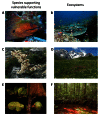Rare species support vulnerable functions in high-diversity ecosystems
- PMID: 23723735
- PMCID: PMC3665844
- DOI: 10.1371/journal.pbio.1001569
Rare species support vulnerable functions in high-diversity ecosystems
Abstract
Around the world, the human-induced collapses of populations and species have triggered a sixth mass extinction crisis, with rare species often being the first to disappear. Although the role of species diversity in the maintenance of ecosystem processes has been widely investigated, the role of rare species remains controversial. A critical issue is whether common species insure against the loss of functions supported by rare species. This issue is even more critical in species-rich ecosystems where high functional redundancy among species is likely and where it is thus often assumed that ecosystem functioning is buffered against species loss. Here, using extensive datasets of species occurrences and functional traits from three highly diverse ecosystems (846 coral reef fishes, 2,979 alpine plants, and 662 tropical trees), we demonstrate that the most distinct combinations of traits are supported predominantly by rare species both in terms of local abundance and regional occupancy. Moreover, species that have low functional redundancy and are likely to support the most vulnerable functions, with no other species carrying similar combinations of traits, are rarer than expected by chance in all three ecosystems. For instance, 63% and 98% of fish species that are likely to support highly vulnerable functions in coral reef ecosystems are locally and regionally rare, respectively. For alpine plants, 32% and 89% of such species are locally and regionally rare, respectively. Remarkably, 47% of fish species and 55% of tropical tree species that are likely to support highly vulnerable functions have only one individual per sample on average. Our results emphasize the importance of rare species conservation, even in highly diverse ecosystems, which are thought to exhibit high functional redundancy. Rare species offer more than aesthetic, cultural, or taxonomic diversity value; they disproportionately increase the potential breadth of functions provided by ecosystems across spatial scales. As such, they are likely to insure against future uncertainty arising from climate change and the ever-increasing anthropogenic pressures on ecosystems. Our results call for a more detailed understanding of the role of rarity and functional vulnerability in ecosystem functioning.
Conflict of interest statement
The authors have declared that no competing interests exist.
Figures




Comment in
-
An inordinate fondness of rarity.PLoS Biol. 2013;11(5):e1001573. doi: 10.1371/journal.pbio.1001573. Epub 2013 May 28. PLoS Biol. 2013. PMID: 23723738 Free PMC article. No abstract available.
References
-
- Gaston KJ (1994) Rarity. London: Chapman & Hall. 192 p.
-
- Hartley S, Kunin WE (2003) Scale dependency of rarity, extinction risk, and conservation priority. Conserv Biol 17: 1559–1570.
-
- Rabinowitz D (1981) Seven forms of rarity. In: Synge H, editor. The biological aspects of rare plant conservation. New York: Wiley.
-
- Dulvy NK, Sadovy Y, Reynolds JD (2003) Extinction vulnerability in marine populations. Fish Fish 4: 25–64.
-
- Lavergne S, Thuiller W, Molina J, Debussche M (2005) Environmental and human factors influencing rare plant local occurrence, extinction and persistence: a 115-year study in the Mediterranean region. J Biogeogr 32: 799–811.
Publication types
MeSH terms
Grants and funding
LinkOut - more resources
Full Text Sources
Other Literature Sources
Research Materials
Miscellaneous

